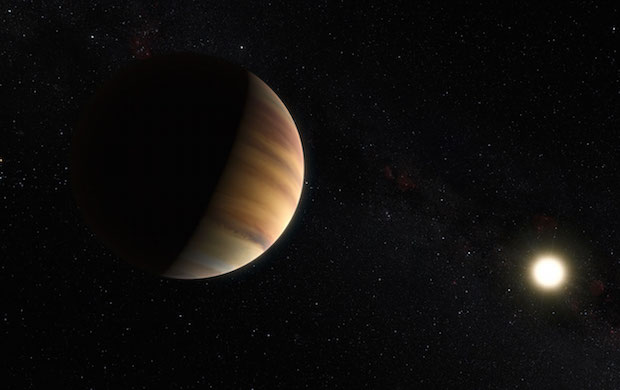
The first ever direct detection of reflected light from an exoplanet, namely 51 Pegasi b, the first exoplanet ever discovered around a normal star, has been made by astronomers at the ESO’s La Silla Observatory in Chile.
Using the HARPS instrument on the European Southern Observatory’s 3.6-metre telescope, the team led by Jorge Martins from the Instituto de Astrofísica e Ciências do Espaço (IA) and the Universidade do Porto, Portugal, used a new technique that uses the host star’s own spectrum to search for a similar signature of light in the orbiting exoplanet’s optical spectrum. By enhancing the minute planetary signal hidden within the host star’s data, the team were able to reveal properties of this pioneering exoplanet that would otherwise prove difficult to establish due to signals that are generally too weak to be detected by other means.
“The main advantage of this method is that we were able to calculate the real mass and orbital inclination [of 51 Pegasi b], allowing a better characterisation of the planetary orbit, something which cannot be done from photometric observations,” explains Martins.
Already known to be a hot Jupiter type exoplanet, the observations by the team confirm that 51 Pegasi b has a mass about half that of Jupiter’s, although it is larger in diameter than Jupiter, and that it has a high albedo (albedo measures the fraction of incident light that is reflected by the planet atmosphere). 51 Pegasi b also has an orbit with an inclination of about nine degrees to the direction to the Earth, meaning that the planet’s orbit is close to being edge on as seen from our perspective.
At present, the characteristics of exoplanets are studied primarily via one of two methods, either by observing the system when the star passes in front of the planet, or by the transmission spectroscopy technique. This latter method relies on observing the host star’s spectrum as it is filtered by a planet’s atmosphere during a transit. Studying the reflected light of a planet may not seem an obvious way to observe it, but it has its advantages.
“Observing in visible light is advantageous because we do not have to worry about the thermal (emitted) spectrum, as most of the light we get from the planet in the optical spectrum is reflected light. By getting the reflected signal, we are able to estimate the reflectivity/albedo of the planet, which in the future might be used to constrain planetary atmospheric models,” explains Martins. One explanation for why exoplanets might have high albedos is the presence of condensates in the atmosphere scattering the light, and as different condensates scatter light in different ways, it may be possible to infer the chemical characteristics of an exoplanet’s atmosphere.
These encouraging results highlight the type of work that can be performed with existing observing facilities, but what could be achieved when current technology is surpassed by more advanced instruments on larger telescopes? “At this moment, we have only observed 51 Pegasi b. We are currently working on acquiring more data from other targets, mostly hot jupiters. The greatest opportunities will come with the advent of the next generation of instruments (e.g. ESPRESSO at the Very Large Telescope) and telescopes (e.g. ESO’s E-ELT and similar), where we should be able to probe [exoplanets] at lower mass ranges and increasing distances,” concludes Martins.



